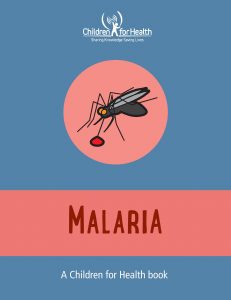April Topic | Malaria | What Children Can Do?

Our April topic is Malaria.
Our 100 Health Messages for Children to Learn and Share are simple, reliable health education messages aimed at children aged 8-14, this includes young adolescents aged 10-14. We feel that it is especially useful and important to make sure that young adolescents are informed as this age group often cares for young children in their families. Also, it’s important to recognise and praise the work they are doing to help their families in this way.
The messages are arranged as 10 messages in 10 key health topics: Malaria, Diarrhoea, Nutrition, Coughs, Colds & Pneumonia, Intestinal Worms, Water, Sanitation & Hygiene, Immunisation, HIV & Aids, Accidents & Preventing Injuries and Caring for Babies & Young Children. The simple health messages are for parents and health educators to use with children at home and in schools, clubs and clinics.
Our messages on Malaria:
- Malaria is a disease spread by the bite of an infected mosquito.
- Malaria is dangerous. It causes fever and can kill, especially children and pregnant women.
- Prevent malaria by sleeping under insecticide-treated bed nets that kill mosquitoes and stop them biting.
- Malaria mosquitoes often bite between sunset and sunrise.
- When children get malaria they may grow and develop more slowly.
- There are three types of insecticide spraying to kill malaria mosquitoes: in houses, in the air and onto water.
- The signs for malaria are high fever, headaches, muscle and stomach aches, and chills. Rapid tests and treatment saves lives.
- Malaria can be prevented and treated with medicine as directed by a health worker.
- Malaria lives in an infected person’s blood and can cause anaemia, which makes them tired and weak.
- Anti-malaria pills can prevent or reduce malaria and anaemia in places and at times when there is lots of malaria in a community.
These health messages have been reviewed by expert health educators and medical experts and are available on the Health ORB website too.



What can children Make, Do & Ask to better understand this topic?
Here are some ideas for activities children can do to understand more about our April topic and share the messages with others.
- MAKE our own Malaria messages using our own words in our own language!
- MEMORISE the messages so we never forget them!
- SHARE these messages with other children and our families!
- MAKE posters to show others how malaria spreads and how we can join the fight to prevent malaria!
- MAKE up stories or plays about the life cycle of the mosquito to tell or perform to other children!
- MAKE posters to show how to use and take care of insecticide treated bed nets!
- TELL stories and make posters to show others how to prevent mosquitoes biting.
- CREATE stories or dramas to show how a child recognises the signs of malaria in another child and asks the adults to take her for a test!
- CREATE stories or drama about the signs for malaria and anaemia, how worms lead to anaemia and how malaria leads to anaemia too.
- MAKE posters about iron rich food in our community.
- HELP younger children stay under the net when mosquitoes are biting!
- MAKE sure bed nets are tucked in properly and have no holes!
- CREATE stories or drama about why people do and don’t like nets and what they believe the nets do and don’t do!
- ORGANISE a campaign to show people how to use nets!
- INVITE a health worker to visit our school and talk to older children about nets and tests!
- USE song, dance and drama to share the messages with others!
- ASK how many people in our family have had malaria? How we can prevent malaria? How and when to hang up long lasting insecticide treated bed nets (LLINs) and use window screens and how do they work? When can people get LLINs in the community? How does malaria kill? Why is malaria especially dangerous for pregnant women and children? What do health workers give women who are having a baby to stop them getting malaria and when do they get it? How do iron and iron rich foods rich foods (meat, some cereals and green leafy vegetables) help to prevent anaemia? How can people protect themselves and each other from mosquito bites? What do you call the special tests to check if malaria is present in the blood?
For more information on our April topic visit our Malaria page.
For anything else, e-mail clare@childrenforhealth.org

